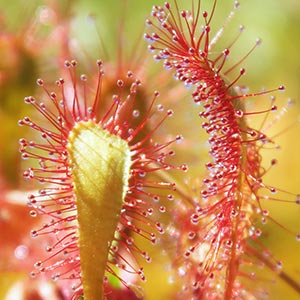Drosera anglica
Drosera capillaris
droséra d'angleterre, English sundew, giant sundew, great sundew, line-leaf sundew, long leaf sundew
pink sundew
erect;
stipules entirely adnate to petioles, 5 mm, margins fimbriate along distal 1/2;
petiole differentiated from blade, 3–7 cm, glabrous or sparsely glandular-hairy;
blade obovate to elongate-spatulate, 1.5–3.5(–5) cm × 3–7 mm.
prostrate;
stipules free from or adnate to petioles to 1 mm, then breaking into setaceous segments 3–5 mm;
petiole differentiated from blade, 0.6–4 cm, sparsely glandular-pilose;
blade broadly spatulate to orbiculate, 0.5–1 cm × 3–5 mm, usually at least slightly longer than broad, usually shorter than petiole.
1–12-flowered;
scapes 3–25 cm, glabrous.
2–20-flowered;
scapes 4–20(–35) cm, glabrous.
8–10 mm diam.;
sepals connate basally, oblong, 5–6 × 4–5 mm, minutely glandular-denticulate;
petals usually white, rarely pinkish, spatulate, 5–6 × 2–3.5 mm.
10 mm diam.;
sepals connate basally, oblong-elliptic, 3–4 × 1–2 mm, apex obtuse, glabrous;
petals usually pink, sometimes white, obovate, 6–7 × 2–3 mm.
4–6 mm, minutely tuberculose.
4–5 mm, longer than sepals.
black, sigmoid-fusiform, 1–1.5 mm, length 1–2 times width, longitudinally striate-areolate.
brown, ellipsoid to oblong-ovoid, asymmetric, 0.4–0.5 mm, coarsely papillose-corrugated, 14–16-ridged.
= 40.
= 20.
Drosera anglica
Drosera capillaris
Drosera anglica is a boreal species that occurs on calcareous substrates. It often grows with D. rotundifolia in peat bogs, and with D. linearis and D. rotundifolia in marl fens, especially in the Great Lakes region. C. E. Wood Jr. (1955) presented a strong case for the hybrid origin of D. anglica, suggesting that it arose as a fertile amphiploid hybrid between D. rotundifolia and D. linearis. It is the only tetraploid North American species of Drosera with 2n = 40. The sterile hybrid D. rotundifolia × D. linearis may be found whenever these species grow together. To avoid confusion, and because a formal name for the sterile hybrid has not been published, it should not be called Drosera ×anglica Hudson, as is commonly done. According to D. E. Schnell (2002), the fertile species may be distinguished from the sterile hybrid by its wider flowers (8–10 mm versus 6–7 mm) and wider scapes (1.5–2 mm versus 1–1.2 mm).
The hybrid between Drosera rotundifolia and D. anglica is a sterile triploid, and has been formally named Drosera ×obovata Mertens & W. D. J. Koch.
Because Drosera longifolia Linnaeus cannot be convincingly typified and has been so often used for plants of D. anglica and D. intermedia in the literature (F. E. Wynne 1944), the name D. longifolia has been rejected as ambiguous.
Drosera anglica is found in the Aalakai Swamp at 1500–2000 meters on the Hawaiian island of Kauai (perhaps brought by migrating birds from Alaska); it is otherwise found in cold northern climates. D. E. Schnell (2002), who has grown the Kauai plants from seed, postulated that the high elevation provides a cooler temperature, and noted that plants from there do not form winter hibernaculae but only smaller winter rosettes.
(Discussion copyrighted by Flora of North America; reprinted with permission.)
Drosera capillaris is the most-frequently encountered species of the genus in the South in moist habitats that can support carnivorous plants, especially in fire-maintained pinelands. Plants can be quite small, or form surprisingly large and robust rosettes (to 12 cm broad) in some places along the Gulf Coast. It is disjunct from the Coastal Plain to Arkansas and Tennessee, as are several other species from coastal wetland habitats. Since the leaf blades of D. capillaris can be somewhat orbiculate, it may be confused with the much more northern D. rotundifolia, which grows more typically in sphagnum (although in its northern range it often grows on moist sand substrates), has adnate stipules, white flowers, and forms hibernaculae.
Drosera capillaris is easy to grow, often behaving as an annual.
(Discussion copyrighted by Flora of North America; reprinted with permission.)
- Local floras:
BC,
CA,
OR,
WA
- Local Web sites:
CalFlora,
CalPhotos,
Flora NW,
Go Botany,
MI Flora,
MN Wildflowers,
PNW Herbaria
WildflowerSearch
iNaturalist (observations)
USDA Plants Database
- LBJ Wildflower Center
- SEINet
- Plants of the World Online
- Encyclopedia of Life
- Wikipedia
- Google Image Search


